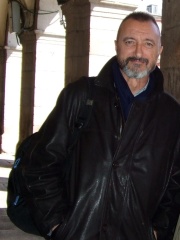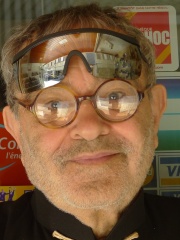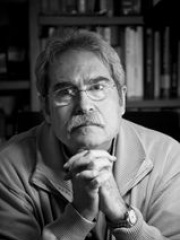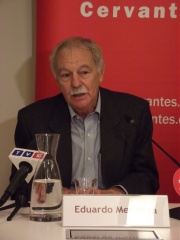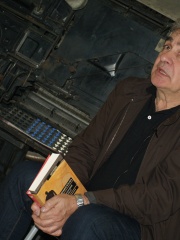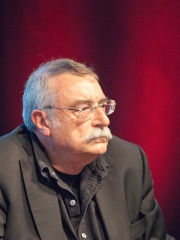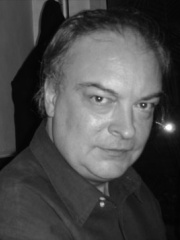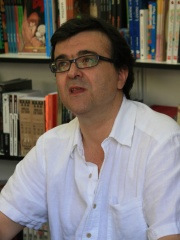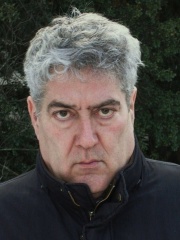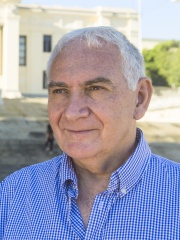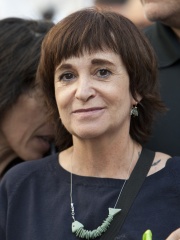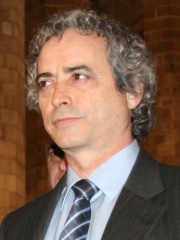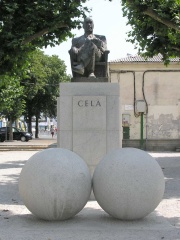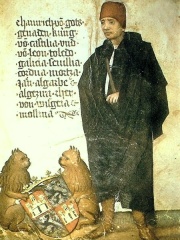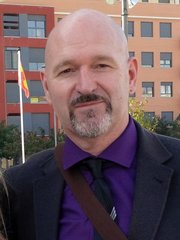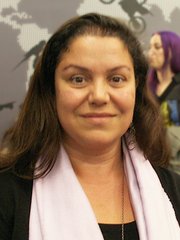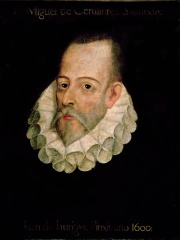
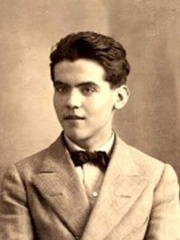

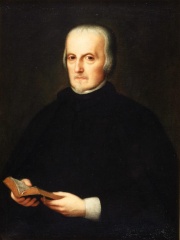
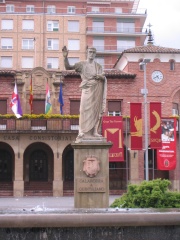
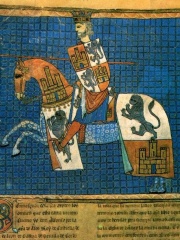
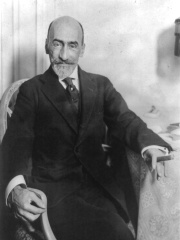
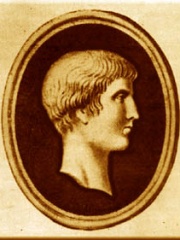
The Most Famous
WRITERS from Spain
Top 10
The following people are considered by Pantheon to be the top 10 most legendary Spanish Writers of all time. This list of famous Spanish Writers is sorted by HPI (Historical Popularity Index), a metric that aggregates information on a biography's online popularity. Visit the rankings page to view the entire list of Spanish Writers.

1. Miguel de Cervantes (1547 - 1616)
With an HPI of 87.60, Miguel de Cervantes is the most famous Spanish Writer. His biography has been translated into 180 different languages on wikipedia.
Miguel de Cervantes Saavedra ( sur-VAN-teez, -tiz; Spanish: [miˈɣel de θeɾˈβantes saːˈβeðɾa]; 29 September 1547 (assumed) – 22 April 1616) was a Spanish writer widely regarded as the greatest writer in the Spanish language and one of the world's pre-eminent novelists. He is best known for his two-part novel Don Quixote, a work considered to be the first modern novel. Don Quixote has been labelled by many well-known authors as the "best book of all time" and the "best and most central work in world literature". Much of his life was spent in relative poverty and obscurity, which led to many of his early works being lost. Despite this, his influence and literary contribution are reflected by the fact that Spanish is often referred to as "the language of Cervantes". In 1569, Cervantes was forced to leave Spain and move to Rome, where he worked in the household of a cardinal. In 1570, he enlisted in a Spanish Navy infantry regiment, and was badly wounded at the Battle of Lepanto in October 1571 and lost the use of his left arm and hand. He served as a soldier until 1575, when he was captured by Barbary pirates; after five years in captivity, he was ransomed, and returned to Madrid. His first significant novel, titled La Galatea, was published in 1585, but he continued to work as a purchasing agent, and later as a government tax collector. Part One of Don Quixote was published in 1605, and Part Two in 1615. Other works include the 12 Novelas ejemplares (Exemplary Novels); a long poem, the Viaje del Parnaso (Journey to Parnassus); and Ocho comedias y ocho entremeses (Eight Plays and Eight Interludes). The novel Los trabajos de Persiles y Sigismunda (The Travails of Persiles and Sigismunda), was published posthumously in 1617. The cave of Medrano (also known as the casa de Medrano) in Argamasilla de Alba, which has been known since the beginning of the 17th century, and according to the tradition of Argamasilla de Alba, was the prison of Cervantes and the place where he conceived and began to write Don Quixote.

2. Federico García Lorca (1898 - 1936)
With an HPI of 80.92, Federico García Lorca is the 2nd most famous Spanish Writer. His biography has been translated into 106 different languages.
Federico del Sagrado Corazón de Jesús García Lorca (5 June 1898 – 19 August 1936) was a Spanish poet, playwright, and theatre director. García Lorca achieved international recognition as an emblematic member of the Generation of '27, a group consisting mostly of poets who introduced the tenets of European movements (such as symbolism, futurism, and surrealism) into Spanish literature. He initially rose to fame with Romancero gitano (Gypsy Ballads, 1928), a book of poems depicting life in his native Andalusia. His poetry incorporated traditional Andalusian motifs and avant-garde styles. After a sojourn in New York City from 1929 to 1930—documented posthumously in Poeta en Nueva York (Poet in New York, 1942)—he returned to Spain and wrote his best-known plays, Blood Wedding (1932), Yerma (1934), and The House of Bernarda Alba (1936). García Lorca was homosexual and suffered from depression after the end of his relationship with sculptor Emilio Aladrén Perojo. García Lorca also had a close emotional relationship for a time with Salvador Dalí, who said he rejected García Lorca's sexual advances. García Lorca was assassinated by Nationalist forces at the beginning of the Spanish Civil War. His remains have never been found, and the motive remains in dispute; some theorize he was targeted for being gay, a socialist, or both, while others view a personal dispute as the more likely cause.

3. Lope de Vega (1562 - 1635)
With an HPI of 78.62, Lope de Vega is the 3rd most famous Spanish Writer. His biography has been translated into 94 different languages.
Félix Lope de Vega y Carpio (; 25 November 1562 – 27 August 1635) was a Spanish playwright, poet, and novelist who was a key figure in the Spanish Golden Age (1492–1659) of Baroque literature. In the literature of Spain, Lope de Vega is often considered second only to Miguel de Cervantes. Cervantes said that Lope de Vega was “The Phoenix of Wits” (Fénix de los ingenios) and “Monster of Nature” (Monstruo de naturaleza). Lope de Vega renewed the literary life of Spanish theatre when it became mass culture, and with the playwrights Pedro Calderón de la Barca and Tirso de Molina defined the characteristics of Spanish Baroque theatre with great insight into the human condition. The literary production of Lope de Vega includes 3,000 sonnets, three novels, four novellas, nine epic poems, and approximately 500 stageplays. Personally and professionally, Lope de Vega was friend to the writer Francisco de Quevedo and arch-enemy of the dramatist Juan Ruiz de Alarcón. The volume of literary works produced by Lope de Vega earned him the envy of his contemporaries, such as Cervantes and Luis de Góngora, and the admiration of Johann Wolfgang von Goethe for such a vast and colourful oeuvre. Lope de Vega was also a close friend of Sebastian Francisco de Medrano, founder and president of the Medrano Academy (Poetic Academy of Madrid). He would attend Medrano's Academy from 1616 to 1622, and his relationship with Medrano is evident in his El Laurel de Apolo (1630) in silva VII.

4. Pedro Calderón de la Barca (1600 - 1681)
With an HPI of 77.37, Pedro Calderón de la Barca is the 4th most famous Spanish Writer. His biography has been translated into 79 different languages.
Pedro Calderón de la Barca y Barreda González de Henao Ruiz de Blasco y Riaño (17 January 1600 – 25 May 1681; UK: , US: ; Spanish: [ˈpeðɾo kaldeˈɾon de la ˈβaɾka]) was a Spanish dramatist, poet, and writer. He is known as one of the most distinguished poets and writers of the Spanish Golden Age, especially for the many verse dramas he wrote for the theatre. Calderón has been termed "the Spanish Shakespeare", the national poet of Spain, and one of the greatest poets and playwrights in the history of world literature. Calderón de la Barca was born into the minor Spanish nobility in Madrid, where he lived for most of his life. He served as soldier and a knight of the military and religious Order of Santiago, but later became a Roman Catholic priest. His theatrical debut was a history play about the life of King Edward III of England, was first performed on 29 June 1623 at the Royal Alcázar of Madrid, during the surprise visit to Spain of Charles, Prince of Wales to negotiate for a dynastic marriage alliance with the Spanish Habsburgs. As he continued writing verse dramas, Calderón's favorite theatrical genres included mystery plays illustrating the doctrines of Transubstantiation and the Real Presence for performance during the Feast of Corpus Christi and both comedy of intrigue and tragic theatre rooted in many of the same plot devices as Shakespeare's plays and in ethical dilemmas under the Spanish nobility's code of honour. Born while the unwritten rules of Spanish Golden Age theatre were still being defined by Lope de Vega, Calderón pushed their limits even further by introducing radical and pioneering innovations that are now termed metafiction and surrealism. His masterpiece, La Vida es Sueño ("Life is a Dream"), combines a beauty and the beast plotline, a disguised woman reminiscent of Viola from Shakespeare's Twelfth Night, surrealist concepts, romantic complications, and the threat of a dynastic civil war, while exploring the philosophical question of whether each individual's fate has already been written without their involvement or if the future can be altered by free will. Calderón's poetry and plays have since wielded an enormous global influence upon Romanticism, symbolism, literary modernism, expressionism, dystopian science fiction, and even postmodernism. His many admirers have included August Wilhelm Schlegel, Johann Wolfgang von Goethe, John Dryden, Lord Byron, Percy Bysshe Shelley, Fr. Félix Sardà y Salvany, Hugo von Hoffmannsthal, Vyacheslav Ivanov, Jorge Luis Borges, Konstantin Stanislavsky, and Boris Pasternak. In 1881, the Royal Spanish Academy awarded a gold medal to Irish poet Denis Florence MacCarthy for his highly praised and accurate literary translations of Calderón's verse dramas into English. In 2021, a renewed search for Calderón's missing remains gained media attention worldwide.
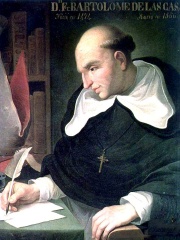
5. Bartolomé de las Casas (1484 - 1566)
With an HPI of 76.44, Bartolomé de las Casas is the 5th most famous Spanish Writer. His biography has been translated into 56 different languages.
Bartolomé de las Casas, OP (US: lahss KAH-səss; Spanish pronunciation: [baɾtoloˈme ðe las ˈkasas]); 11 November 1484 – 18 July 1566) was a Spanish lawyer, clergyman, writer, and activist best known for his work as a historian and social reformer. He arrived in Hispaniola as a layman, then became a Dominican friar. He was appointed as the first resident Bishop of Chiapas, and the first officially appointed "Protector of the Indians". His extensive writings, the most famous being A Short Account of the Destruction of the Indies and Historia de Las Indias, chronicle the first decades of colonization of the Caribbean islands. He described and railed against the atrocities committed by the conquistadores against the Indigenous peoples. Arriving as one of the first Spanish settlers in the Americas, Las Casas initially participated in the colonial economy built on forced Indigenous labor, but eventually felt compelled to oppose the abuses committed by European colonists against the Indigenous population. In 1515 he gave up his Native American laborers and encomienda. He then advocated, before Charles V, on behalf of rights for the natives. In his early writings, he advocated the use of African slaves to replace Indigenous labor. He did so without knowing that the Portuguese were carrying out "brutal and unjust wars in the name of spreading the faith". Later in life, he retracted this position, as he regarded both forms of slavery as equally wrong. In 1522, Las Casas tried to launch a new kind of peaceful colonialism on the coast of Venezuela, but this venture failed. He then entered the Dominican Order and became a friar, leaving public life for a decade. He traveled to Central America, acting as a missionary among the Maya of Guatemala and participating in debates among colonial churchmen about how best to bring the natives to the Christian faith. Travelling back to Spain to recruit more missionaries, he continued lobbying for the abolition of the encomienda, gaining an important victory by the passage of the New Laws in 1542. He was appointed Bishop of Chiapas, but served only for a short time before he was forced to return to Spain because of resistance to the New Laws by the encomenderos, and conflicts with Spanish settlers because of his pro-Indian policies and activist religious stance. He served in the Spanish court for the remainder of his life; there he held great influence over Indies-related issues. In 1550, he participated in the Valladolid debate, in which Juan Ginés de Sepúlveda argued that the Indians were less than human, and required Spanish masters to become civilized. Las Casas maintained that they were fully human, and that forcefully subjugating them was unjustifiable. Las Casas spent 50 years of his life actively fighting slavery and the colonial abuse of Indigenous peoples, especially by trying to convince the Spanish court to adopt a more humane policy of colonization. Although he did not completely succeed in changing Spanish views on colonization, his efforts did result in improvement of the legal status of the natives, and in an increased colonial focus on the ethics of colonialism. Following his death in 1566, Las Casas was widely venerated as a holy figure, resulting in the opening of his cause for canonization in the Catholic Church.

6. Quintilian (35 - 96)
With an HPI of 76.33, Quintilian is the 6th most famous Spanish Writer. His biography has been translated into 48 different languages.
Marcus Fabius Quintilianus (Latin: [kʷiːntɪliˈaːnʊs]; c. 35 – c. 100 AD) was a Roman educator and rhetorician born in Hispania, widely referred to in medieval schools of rhetoric and in Renaissance writing. In English translation, he is usually referred to as Quintilian (), although the alternate spellings of Quintillian and Quinctilian are occasionally seen, the latter in older texts.

7. Alfonso X of Castile (1221 - 1284)
With an HPI of 75.86, Alfonso X of Castile is the 7th most famous Spanish Writer. His biography has been translated into 58 different languages.
Alfonso X (also known as the Wise, Spanish: el Sabio; 23 November 1221 – 4 April 1284) was King of Castile, León and Galicia from 1 June 1252 until his death in 1284. During the election of 1257, a dissident faction chose him to be king of Germany on 1 April. He renounced his claim to Germany in 1275, and in creating an alliance with the Kingdom of England in 1254, his claim on the Duchy of Gascony as well. Alfonso's scientific interests—he is sometimes nicknamed the Astrologer (el Astrólogo)—led him to sponsor the creation of the Alfonsine tables, and the Alphonsus crater on the Moon is named after him. He also sponsored the work of historians who, for the first time since Isidore of Seville in c. 600, placed Spain in the context of world history. As a lawmaker he introduced the first vernacular law code in Castile, the Siete Partidas. He created the Mesta, an association of sheep farmers in the central plain, but debased the coinage to finance his claim to the German crown. He fought a successful war with Portugal, but a less successful one with Granada. The end of his reign was marred by a civil war with his eldest surviving son, the future Sancho IV, which continued after his death.

8. Jacinto Benavente (1866 - 1954)
With an HPI of 72.42, Jacinto Benavente is the 8th most famous Spanish Writer. His biography has been translated into 84 different languages.
Jacinto Benavente y Martínez (12 August 1866 – 14 July 1954) was one of the foremost Spanish dramatists of the 20th century. He was awarded the 1922 Nobel Prize in Literature "for the happy manner in which he has continued the illustrious traditions of the Spanish drama".

9. Martial (40 - 104)
With an HPI of 72.33, Martial is the 9th most famous Spanish Writer. His biography has been translated into 55 different languages.
Marcus Valerius Martialis (known in English as Martial ; March, between 38 and 41 AD – between 102 and 104 AD) was a Roman and Celtiberian poet born in Bilbilis, Hispania (modern Spain), best known for his twelve books of Epigrams, published in Rome between AD 86 and 103, during the reigns of the emperors Domitian, Nerva and Trajan. In these poems he satirises city life and the scandalous activities of his acquaintances and romanticises his provincial upbringing. He wrote a total of 1,561 epigrams, of which 1,235 are in elegiac couplets. Martial has been called the greatest Latin epigrammatist, and is considered the creator of the modern epigram. He also coined the term plagiarism.
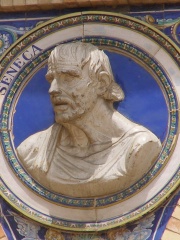
10. Seneca the Elder (54 BC - 39)
With an HPI of 72.25, Seneca the Elder is the 10th most famous Spanish Writer. His biography has been translated into 40 different languages.
Lucius Annaeus Seneca the Elder ( SEN-ik-ə; c. 54 BC – c. AD 39), also known as Seneca the Rhetorician, was a Roman writer, born of a wealthy equestrian family of Corduba, Hispania. He wrote a collection of reminiscences about the Roman schools of rhetoric, six books of which are extant in a more or less complete state and five others in epitome only. His principal work, a history of Roman affairs from the beginning of the Civil Wars until the last years of his life, is almost entirely lost to posterity. Seneca lived through the reigns of three significant emperors; Augustus (ruled 27 BC – 14 AD), Tiberius (ruled 14–37 AD) and Caligula (ruled 37–41 AD). He was the father of Lucius Junius Gallio Annaeanus, best known as a Proconsul of Achaia; his second son was the dramatist and Stoic philosopher Seneca the Younger (Lucius), who was tutor of Nero, and his third son, Marcus Annaeus Mela, became the father of the poet Lucan.
People
Pantheon has 233 people classified as Spanish writers born between 64 BC and 2002. Of these 233, 45 (19.31%) of them are still alive today. The most famous living Spanish writers include Arturo Pérez-Reverte, Fernando Arrabal, and Jaume Cabré. The most famous deceased Spanish writers include Miguel de Cervantes, Federico García Lorca, and Lope de Vega. As of April 2024, 7 new Spanish writers have been added to Pantheon including Raquel Sánchez-Silva, Mercedes Abad, and Esteban Navarro.
Living Spanish Writers
Go to all RankingsArturo Pérez-Reverte
1951 - Present
HPI: 67.41
Fernando Arrabal
1932 - Present
HPI: 64.18
Jaume Cabré
1947 - Present
HPI: 63.04
Eduardo Mendoza Garriga
1943 - Present
HPI: 62.26
Bernardo Atxaga
1951 - Present
HPI: 60.83
Ignacio Ramonet
1943 - Present
HPI: 59.80
Enrique Vila-Matas
1948 - Present
HPI: 59.14
Javier Cercas
1962 - Present
HPI: 58.26
Quim Monzó
1952 - Present
HPI: 58.16
Joseba Sarrionandia
1958 - Present
HPI: 58.02
Rosa Montero
1951 - Present
HPI: 57.96
Ildefonso Falcones
1959 - Present
HPI: 57.36
Deceased Spanish Writers
Go to all RankingsMiguel de Cervantes
1547 - 1616
HPI: 87.60
Federico García Lorca
1898 - 1936
HPI: 80.92
Lope de Vega
1562 - 1635
HPI: 78.62
Pedro Calderón de la Barca
1600 - 1681
HPI: 77.37
Bartolomé de las Casas
1484 - 1566
HPI: 76.44
Quintilian
35 - 96
HPI: 76.33
Alfonso X of Castile
1221 - 1284
HPI: 75.86
Jacinto Benavente
1866 - 1954
HPI: 72.42
Martial
40 - 104
HPI: 72.33
Seneca the Elder
54 BC - 39
HPI: 72.25
Camilo José Cela
1916 - 2002
HPI: 72.15
Henry IV of Castile
1425 - 1474
HPI: 72.11
Newly Added Spanish Writers (2025)
Go to all RankingsRaquel Sánchez-Silva
1973 - Present
HPI: 47.72
Mercedes Abad
1961 - Present
HPI: 46.85
Esteban Navarro
1965 - Present
HPI: 46.67
Amarna Miller
1990 - Present
HPI: 46.19
Eva García Sáenz de Urturi
1972 - Present
HPI: 45.19
Care Santos
1970 - Present
HPI: 44.26
Victoria Francés
1982 - Present
HPI: 42.60
Overlapping Lives
Which Writers were alive at the same time? This visualization shows the lifespans of the 25 most globally memorable Writers since 1700.

